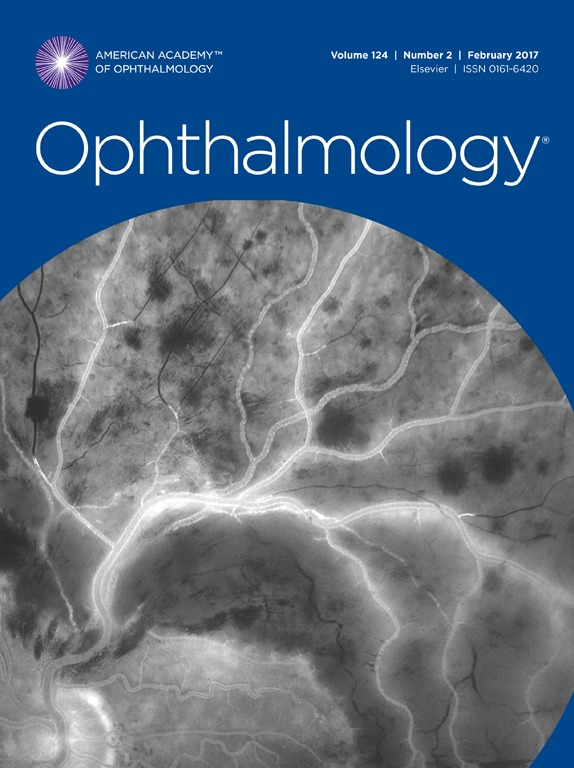血浆代谢组学确定关键代谢物并改进糖尿病视网膜病变预测:跨国队列的开发与验证。
IF 13.1
1区 医学
Q1 OPHTHALMOLOGY
引用次数: 0
摘要
目的:确定糖尿病视网膜病变(DR)的纵向代谢组指纹图谱,并评估其在预测DR发展和恶化方面的作用:设计:多中心、多种族队列研究:本研究纳入了英国生物库(UKB)中基线糖尿病前期/糖尿病的17675名参与者,这些参与者符合2021年美国糖尿病协会指南,且基线无DR;另外还纳入了广州糖尿病眼病研究(GDES)中的638名糖尿病参与者,以进行外部验证:方法:通过核磁共振检测确定了英国生物库参与者的纵向DR代谢组指纹。在完全隐蔽的测试集中评估了这些指纹对预测 DR 发展的预测价值。在 GDES 队列中对 DR 进展和微血管损伤进行了外部验证和外推分析。模型评估包括两个队列的C统计量、净分类改进(NRI)、综合判别改进(IDI)、校准和临床实用性:结果:结果:在168个代谢物中,有118个被确定为未来DR发展的候选代谢组指纹。这些指纹比传统指标大大提高了DR发展的可预测性(C统计量:0.802,95% CI,0.760-0.843 vs. 0.751,95% CI,0.706-0.796;P = 5.56×10-4)。葡萄糖、乳酸盐和柠檬酸盐是在 GDES 队列中得到验证的指纹。在外部队列中,使用这些简化且可复制的指纹预测 DR 的发展(C 统计量:0.807,95% CI,0.711-0.903 vs. 0.617,95% CI,0.494,0.740;P = 1.68×10-4)和进展(C 统计量:0.797,95% CI,0.712-0.882 vs. 0.665,95% CI,0.545-0.784;P = 0.003)有相似的改善。在两个队列中,NRIs、IDIs 和临床效用的改善也很明显(均为 P 结论:事实证明,代谢组学图谱分析能有效确定预测未来 DR 发展和进展的可靠指纹图谱,为 DR 病理生理学的早期和晚期阶段提供新的见解。本文章由计算机程序翻译,如有差异,请以英文原文为准。
Plasma Metabolomics Identifies Key Metabolites and Improves Prediction of Diabetic Retinopathy
Purpose
To identify longitudinal metabolomic fingerprints of diabetic retinopathy (DR) and to evaluate their usefulness in predicting DR development and progression.
Design
Multicenter, multiethnic cohort study.
Participants
This study included 17 675 participants from the UK Biobank (UKB) who had baseline prediabetes or diabetes, identified in accordance with the 2021 American Diabetes Association guidelines, and were free of baseline DR and an additional 638 participants with type 2 diabetes mellitus from the Guangzhou Diabetic Eye Study (GDES) for external validation. Diabetic retinopathy was determined by ICD-10 codes in the UKB cohort and revised ETDRS grading criteria in the GDES cohort.
Methods
Longitudinal DR metabolomic fingerprints were identified through nuclear magnetic resonance (NMR) assay in UKB participants. The predictive value of these fingerprints for predicting DR development were assessed in a fully withheld test set. External validation and extrapolation analyses of DR progression and microvascular damage were conducted in the GDES cohort using NMR technology. Model assessments included the concordance (C) statistic, net classification improvement (NRI), integrated discrimination improvement (IDI), calibration, and clinical usefulness in both cohorts.
Main Outcome Measures
DR development and progression and retinal microvascular damage.
Results
Of 168 metabolites, 118 were identified as candidate metabolomic fingerprints for future DR development. These fingerprints significantly improved the predictability for DR development beyond traditional indicators (C statistic, 0.802 [95% confidence interval (CI), 0.760–0.843] vs. 0.751 [95% CI, 0.706–0.796]; P = 5.56 × 10−4). Glucose, lactate, and citrate were among the fingerprints validated in the GDES cohort. Using these parsimonious and replicable fingerprints yielded similar improvements for predicting DR development (C statistic, 0.807 [95% CI, 0.711–0.903] vs. 0.617 [95% CI, 0.494–0.740]; P = 1.68 × 10−4) and progression (C statistic, 0.797 [95% CI, 0.712–0.882] vs. 0.665 [95% CI, 0.545–0.784]; P = 0.003) in the external GDES cohort. Improvements in NRIs, IDIs, and clinical usefulness also were evident in both cohorts (all P < 0.05). In addition, lactate and citrate were associated with microvascular damage across macular and optic nerve head regions among Chinese GDES (all P < 0.05).
Conclusions
Metabolomic profiling may be effective in identifying robust fingerprints for predicting future DR development and progression, providing novel insights into the early and advanced stages of DR pathophysiology.
Financial Disclosure(s)
The author(s) have no proprietary or commercial interest in any materials discussed in this article.
求助全文
通过发布文献求助,成功后即可免费获取论文全文。
去求助
来源期刊

Ophthalmology
医学-眼科学
CiteScore
22.30
自引率
3.60%
发文量
412
审稿时长
18 days
期刊介绍:
The journal Ophthalmology, from the American Academy of Ophthalmology, contributes to society by publishing research in clinical and basic science related to vision.It upholds excellence through unbiased peer-review, fostering innovation, promoting discovery, and encouraging lifelong learning.
 求助内容:
求助内容: 应助结果提醒方式:
应助结果提醒方式:


